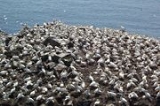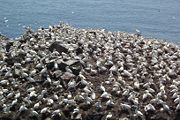
Cape St. Mary's Ecological Reserve
Encyclopedia
Cape St. Mary's Ecological Reserve is a wildlife reserve located near Cape St. Mary's
on the Cape Shore
, on the southwestern Avalon Peninsula
of Newfoundland.
 It is home to one of Newfoundland's largest seabird colonies. The government of Newfoundland and Labrador estimates that the site is home to 24,000 Northern Gannet
It is home to one of Newfoundland's largest seabird colonies. The government of Newfoundland and Labrador estimates that the site is home to 24,000 Northern Gannet
s, 20,000 Black-legged Kittiwake
s, 20,000 Common Murres, and 2,000 Thick-billed Murres, as well as dozens or hundreds of Razorbill
, and Black Guillemot
breeding pairs. The ocean waters off the reserve also provides winter habitat for Harlequin Duck
s, Common Eider
s, Scoter
s, and Long-tailed Duck
s.
In addition to the numerous birds, humpback whales may be viewed from the heights during the annual capelin
run.
The area protected by the reserve also includes sub-Arctic tundra
, a mainly treeless plateau bordering the ocean.
Facilities include an interpretive centre, parking and washrooms. A footpath from the centre leads to a viewing location a few hundred metres from "Bird Rock", a large sea stack
with several thousand nesting gannets. Other nesting locations can also be viewed from shore.
A lighthouse
is also located near the interpretive centre. As is true for many parts of Newfoundland, fog can be encountered at any time of day. Care should be taken near cliff edges.
Cape St. Mary's
The headland of Cape St. Mary's is located at the southern tip of the south-western arm of the Avalon Peninsula of the island of Newfoundland in the Canadian province of Newfoundland and Labrador.Cape St...
on the Cape Shore
Cape Shore
- Overview :The Cape Shore is a region on the southwestern portion of the Avalon Peninsula on the island of Newfoundland.Often confused or conflated with the Southern Shore , the Cape Shore is similarly rural and populated by Irish Newfoundlanders, but is geographically distinct...
, on the southwestern Avalon Peninsula
Avalon Peninsula
The Avalon Peninsula is a large peninsula that makes up the southeast portion of the island of Newfoundland.The peninsula is home to 257,223 people, which is approximately 51% of Newfoundland's population in 2009, and is the location of the provincial capital, St. John's. It is connected to the...
of Newfoundland.

Northern Gannet
The Northern Gannet is a seabird and is the largest member of the gannet family, Sulidae.- Description :Young birds are dark brown in their first year, and gradually acquire more white in subsequent seasons until they reach maturity after five years.Adults are long, weigh and have a wingspan...
s, 20,000 Black-legged Kittiwake
Black-legged Kittiwake
The Black-legged Kittiwake is a seabird species in the gull family Laridae.This species was first described by Linnaeus in his Systema naturae in 1758 as Larus tridactylus....
s, 20,000 Common Murres, and 2,000 Thick-billed Murres, as well as dozens or hundreds of Razorbill
Razorbill
The Razorbill is colonial seabird that will only come to land in order to breed. It is the largest living member of the Auk family. This agile bird will choose only one partner for life and females will lay one egg per year. Razorbills will nest along coastal cliffs in enclosed or slightly exposed...
, and Black Guillemot
Black Guillemot
The Black Guillemot or Tystie is a medium-sized alcid.Adult birds have black bodies with a white wing patch, a thin dark bill, and red legs and feet. They show white wing linings in flight. In winter, the upperparts are pale grey and the underparts are white. The wings remain black with the large...
breeding pairs. The ocean waters off the reserve also provides winter habitat for Harlequin Duck
Harlequin Duck
The Harlequin Duck is a small sea duck. It takes its name from Arlecchino, Harlequin in French, a colourfully dressed character in Commedia dell'arte. The species name comes from the Latin word "histrio", "actor". In North America it is also known as Lords and ladies...
s, Common Eider
Common Eider
The Common Eider, Somateria mollissima, is a large sea-duck that is distributed over the northern coasts of Europe, North America and eastern Siberia. It breeds in Arctic and some northern temperate regions, but winters somewhat farther south in temperate zones, when it can form large flocks on...
s, Scoter
Scoter
The scoters are stocky seaducks in the genus Melanitta. The drakes are mostly black and have swollen bills. Females are brown.They breed in the far north of Europe, Asia and North America, and winter further south in temperate zones of those continents. They form large flocks on suitable coastal...
s, and Long-tailed Duck
Long-tailed Duck
The Long-tailed Duck or Oldsquaw is a medium-sized sea duck. It is the only living member of its genus, Clangula; this was formerly used for the goldeneyes, with the Long-tailed Duck being placed in Harelda...
s.
In addition to the numerous birds, humpback whales may be viewed from the heights during the annual capelin
Capelin
The capelin or caplin, Mallotus villosus, is a small forage fish of the smelt family found in the Atlantic and Arctic oceans. In summer, it grazes on dense swarms of plankton at the edge of the ice shelf. Larger capelin also eat a great deal of krill and other crustaceans...
run.
The area protected by the reserve also includes sub-Arctic tundra
Tundra
In physical geography, tundra is a biome where the tree growth is hindered by low temperatures and short growing seasons. The term tundra comes through Russian тундра from the Kildin Sami word tūndâr "uplands," "treeless mountain tract." There are three types of tundra: Arctic tundra, alpine...
, a mainly treeless plateau bordering the ocean.
Facilities include an interpretive centre, parking and washrooms. A footpath from the centre leads to a viewing location a few hundred metres from "Bird Rock", a large sea stack
Stack (geology)
A stack is a geological landform consisting of a steep and often vertical column or columns of rock in the sea near a coast, isolated by erosion. Stacks are formed through processes of coastal geomorphology, which are entirely natural. Time, wind and water are the only factors involved in the...
with several thousand nesting gannets. Other nesting locations can also be viewed from shore.
A lighthouse
Lighthouse
A lighthouse is a tower, building, or other type of structure designed to emit light from a system of lamps and lenses or, in older times, from a fire, and used as an aid to navigation for maritime pilots at sea or on inland waterways....
is also located near the interpretive centre. As is true for many parts of Newfoundland, fog can be encountered at any time of day. Care should be taken near cliff edges.

